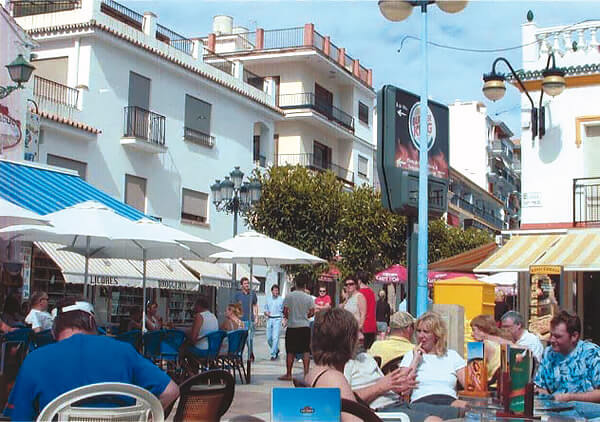Wintering in Southern Spain
Living in Warm and Sunny Costa del Sol is a Budget Escape
Article & Photo by Sharon Freeman
 |
Outdoor café on San Miguel street. |
From the balcony of my apartment, I can see and hear the waves of the Mediterranean lapping gently onto the shore. The sky is crystal clear, and the beach is empty save for a few people walking on the cool sand. The rest
stroll along the Paseo, a walkway that runs for miles along the shore. Spaniards, who love to walk, are bundled in their winter coats, while the Europeans from the north stroll along in their tank tops and shorts, greedily soaking up the winter
sun. From January to March the temperature sits at about 65 degrees.
The Costa del Sol of southern Spain is for many Europeans their Florida or Palm Springs. For many years the British have retired here, and many more still spend months at a time to escape the cold. The hotels are booked
throughout the winter with people from England, France, Belgium, Holland, Denmark, Canada, and America. Many retired Americans from our colder regions have discovered this wonderful winter getaway, where they can migrate to a warmer climate without
paying the big prices so common in the U.S. And if you live on the East Coast, your travel time will not be that much more than a trip to California.
My husband and I were able to book a 2-week stay in Torremolinos for approximately $1,000 per person through a tour operator. If you are not interested in tour packages but would like to get away on your own and relax in this mild climate for the winter, it is easy to do. Leaving from the U.S. you can book a flight with Air France and fly to Paris,
change planes and fly to Malaga, then take a short taxi ride from the airport to Torremolinos.
British Airways offers a similar plan but lands in London and then on to Malaga. The Spanish airline, Iberia, departs only from the East Coast and flies to Madrid, where you change planes and then fly to Malaga. You can
obtain euros at the airport in Malaga by visiting the ATM located near the information booth.
In Spain there are full-service hotels and hotels referred to as apartments, which include kitchenettes. You can find hotel information at visitcostadelsol.com and home rental information at airbnb.com (Costa del Sol).
Once you are in Spain, you can prepare for your next trip by collecting phone numbers of the many apartments available. Many Spaniards who own a home in the city and an apartment by the sea rent the apartments during the
winter months for less than you would pay to stay at a hotel.
I had the pleasure of making friends with Jodi and Arthur, a couple from New York City, who have been visiting Spain for the past three years. Their first trip to Costa del Sol was with a group tour. On their second trip
they booked their own flight and stayed at the same hotel as before, while there they obtained phone numbers of apartments available for rent. Before their third trip the following year they secured a 2-bedroom, 2-bath apartment, with a balcony
facing the sea. On this trip they arrived in late November and stayed through March. The cost of the trip would have been double had they stayed for the same length of time at one of the hotels.
Life on the Costa del Sol
 |
Sun setting over the town of Mijas in the Costa del Sol. |
Jodi and Arthur have given me permission to share some of their discoveries. They cook all their meals at “home,” except for on two days when they go out for dinner at one of the many restaurants or tapas
bars in the area.
Jodi and Arthur love to dance, as do the Spaniards. They attend dance classes two nights a week at one of the local hotels. There is such an interest in dancing that each March the European Dance Competition is held
for one week, with all styles of dancing, including flamenco.
Every month the Costa del Sol Town Council puts together a schedule of free events, which include concerts and art and science exhibits. Most are within walking distance, but for one euro you can take a 20-minute
train ride to Malaga in one direction; 20 minutes in the opposite direction is Fuenguirola, where there’s an outdoor flea market on Tuesdays.
Life is slower in the Costa del Sol. Every day at 2 p.m. the shops close their doors and don’t open them again until 5 p.m. Many native Spaniards and transplanted foreigners use this time to rest, as it was
intended. When 5 p.m. comes around vendors are ready to re-open their shops and put in another four hours. Then after work is done they rush over to a local bar or cafe to meet with their friends and family for a snack before calling it a day.
All vacations must come to an end but no one is anxious to leave. The place grows on you. Besides, summer is around the corner and the area will take on a new face. The Paseo and beaches will be crowded with sunbathers
and children. We will leave it to them and look forward to the winter.
Sharon Freeman and her husband were working at a hotel in southern Spain when she wrote this article. She is now working on a young readers’ adventure story with her father.
|
